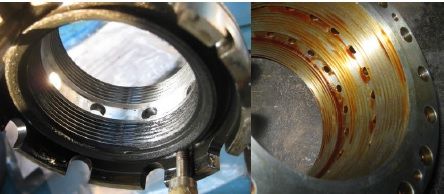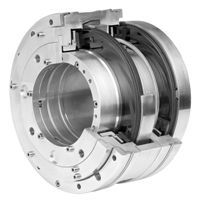Types of centrifugal compressor shaft end seals

Labyrinth seals are the simplest seals ( multiple orifices)
• Low pressures
• Could be made of generally of softer material to prevent damage to rotor. non metallic materials such as PEEK gaining popularity.
• Bearing housing seals and separation seals in dry gas seals are another commonly seen applications.
• In early times labyrinth seals were used as main seals with the help of barrier gas to prevent process gas to come out to the atmospheric side eg Wet Gas compressor application in FCC units.
At the 2016 Asia Turbomachinery & Pump Symposium, Vasanth Bhat of the Singapore Refining Company Pte Ltd gave a presentation on types of centrifugal compressor shaft end seals.
High Reliability , long life
Higher leakages compared to other seals
Lower Cost
Limited to low pressure applications
Easy to install & maintain in most cases
In most cases would need inert gases if applied to applications other than air Support System requirements are simpler.
In recent times carbon segmented seals actively replacing labyrinth seals in the typical applications.
• The clearances are smaller and result in lower leakages.
• Now commonly used in air compressors and low pressure gases .In case of hazardous gas application a barrier gas such as nitrogen is provided to prevent leakage of process gas into atmosphere.
• Very commonly applied in low pressure application such as blowers and now commonly used in dry gas seals as tertiary seals or barrier seals to prevent lube oil contamination into secondary seals.
Quiet Reliable
Not suitable for higher pressures
Lower Cost compared to other seals
In most cases would need inert gases if applied to applications other than air
Easy to install & maintain in most cases with some requirements on mating shaft surface
Leakage higher compared to other seals
Support System requirements are simpler
Wet seals need liquid barrier, in most cases lubricating oil to prevent the gas from leaking to atmosphere.
• They are of circumferential and face type seals in various arrangements.
Can be applied to low to high pressures
Not suitable for higher pressures as it would need a seal oil system of higher then sealing pressure
Lower leaks compared to carbon segmented seals
Life is dependent on quality of Seal oil ,operation and reliability of seal oil system
Don’t fail in a catastrophic manner when gas gets contaminated
Will be expensive system and could increase exponentially with higher pressures
Mixing of lub oil system with seal oil system is not a major concern If seal oil contaminates process gas that would be a limitation to the seal application
Start up & shutdowns are easily managed and don’t need addition of equipment to maintain ideal conditions for the seal

Currently the dry gas seal is the default seal selection for most centrifugal compressor application.
• Capable of handling any type of applications as long as there is clean dry gas available for the seals.
Can be applied to almost entire pressure range
The cost of the seal is highest in most cases for the similar application
Lower leaks compared to other seal types best to meet most difficult emission requirements
Life dependent on quality of seal gas and how it is maintained through out the operation of the compressor
As compressor gas is used in most cases as sealing media the system is relatively simpler
Migration of lube oil to seal side could be pose a serious concern and need special barrier seals
Life of dry gas seals is generally better compared to other seals when operated and maintained well. Failures in many cases are catastrophic in nature resulting in sudden outage of machines sensitive to compressor gas composition changes.